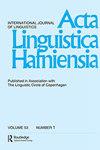墨西哥西班牙语空间指示语双向对比的证据
Q2 Arts and Humanities
引用次数: 1
摘要
摘要本研究为墨西哥西班牙语指示语系统中的二元对比提供了证据。该分析基于以英语为母语的人在3D虚拟现实视频游戏中如何解释指示状语aquí/ ac本文章由计算机程序翻译,如有差异,请以英文原文为准。
Evidence of a two-way contrast in Mexican Spanish spatial deixis
Abstract This study provides evidence for a binary contrast in the deictic system of Mexican Spanish. The analysis is based on experimental data on how native speakers interpret the adverbial demonstratives aquí/acá/ahí/allí/allá in a 3D virtual reality video game. The tests crossed the variables of distance, person, and anaphora. The results revealed that (i) when contrasting degrees of distance and anaphoric reference, ahí primarily has an anaphoric function, while aquí/acá/allí/allá primarily have a deictic function; (ii) acá/aquí designate proximal distances and the domain of the speaker; (iii) ahí designates the domain of the hearer in a person-oriented deixis; and (iv) the meaning of allí and allá cannot be explained by the deictic parameters of distance and person.
求助全文
通过发布文献求助,成功后即可免费获取论文全文。
去求助
来源期刊

Acta Linguistica Hafniensia
Arts and Humanities-Language and Linguistics
CiteScore
0.90
自引率
0.00%
发文量
5
 求助内容:
求助内容: 应助结果提醒方式:
应助结果提醒方式:


